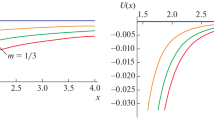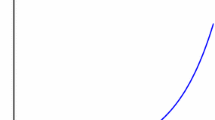Abstract
In order to understand how locally static configurations around gravitationally bound bodies can be embedded in an expanding universe, we investigate the solutions of general relativity describing a space–time whose spatial sections have the topology of a 3-sphere with two identical masses at the poles. We show that Israel junction conditions imply that two spherically symmetric static regions around the masses cannot be glued together. If one is interested in an exterior solution, this prevents the geometry around the masses to be of the Schwarzschild type and leads to the introduction of a cosmological constant. The study of the extension of the Kottler space–time shows that there exists a non-static solution consisting of two static regions surrounding the masses that match a Kantowski–Sachs expanding region on the cosmological horizon. The comparison with a Swiss-Cheese construction is also discussed.
Similar content being viewed by others
References
Birkhoff G.D.: Relativity and Modern Physics, pp. 253. Harvard University Press, Cambridge (1923)
Hawking S.W., Ellis G.F.R.: The Large Scale Structure of Space Time. Cambridge University Press, Cambridge (1973)
Lindquist R.W., Wheeler J.A.: Rev. Mod. Phys. 29, 432 (1957)
Gausmann E. et al.: Class. Quantum Gravity 18, 5155 (2001)
Lehoucq R. et al.: Class. Quantum Gravity 19, 4683 (2002)
Weeks J. et al.: Class. Quantum Gravity 20, 1529 (2003)
Uzan J.-P. et al.: Phys. Rev. D 69, 043003 (2004)
Clifton T., Ferreira P.G.: Phys. Rev. D 80, 103503 (2009)
Clifton T., Ferreira P.G.: JCAP 10, 26 (2009)
Einstein A., Straus E.G.: Rev. Mod. Phys. 17, 120 (1945)
Einstein A., Straus E.G.: Rev. Mod. Phys. 18, 148 (1945)
Kottler F.: Ann. Phys. 56, 401 (1918)
Weyl H.: Phys. Z. 20, 31 (1919)
Israel W.: Nuovo Cimento B 44, 1 (1966)
Israel W.: Nuovo Cimento B 48, 463 (1967)
Schrödinger E.: Expanding Universes. Cambridge University Press, Cambridge (1956)
Jebsen J.T.: Gen. Relativ. Gravit. 37, 2253 (2005)
Deser S.: Gen. Relativ. Gravit. 37, 2251 (2005)
Goldwirth D., Katz J.: Class. Quantum Gravity 12, 769 (1995)
Perlick, V.: Living Rev. Relat. 7, 9 (2004) (section 5.2). http://relativity.livingreviews.org/Articles/lrr-2004-9/.
Boyer R.H.: Proc. R. Soc. A 311, 245 (1969)
Misner, C., Thorne, K.S., Wheeler, J.A.: Gravitation (Freeman, 1973)
Lake K.: Class. Quantum Gravity 23, 5883 (2006)
Israel W.: Phys. Rev. 143, 1016 (1966)
Klösch T., Strobl T.: Class. Quantum Gravity 13, 1191 (1996)
Lake K., Roeder R.C.: Phys. Rev. D 15, 3513 (1977)
Stuchlik Z.: Bull. Astron. Inst. Czechosl. 34, 129 (1983)
Katz J., Lynden-Bell D.: Class. Quantum Gravity 8, 2231 (1991)
Marolf D.: Gen. Relativ. Gravit. 31, 919 (1999)
Gibin J.T., Marolf D., Garvey R.: Gen. Relativ. Gravit. 36, 83 (2004)
Doran, R., Lobo, F., Crawford, P.: gr-qc/0609042
Kantowski R., Sachs R.K.: J. Math. Phys. 7, 443 (1966)
Kantowski R.: Astrophys. J. 155, 89 (1969)
Balbinot R., Bergamini R., Comastri A.: Phys. Rev. D 38, 2415 (1988)
Wiltshire D.L.: New J. Phys. 9, 377 (2007)
Wiltshire, D.L.: In: Pecontal, E., et al. (eds.) Dark Energy and Dark Matter: Observations, Experiments and Theories. EAS Publ. Ser. 36, 91 (2009)
Wiltshire D.L.: Int. J. Mod. Phys. D 18, 2121 (2009)
Marra V. et al.: Phys. Rev.D 76, 123004 (2007)
Author information
Authors and Affiliations
Corresponding author
Rights and permissions
About this article
Cite this article
Uzan, JP., Ellis, G.F.R. & Larena, J. A two-mass expanding exact space-time solution. Gen Relativ Gravit 43, 191–205 (2011). https://doi.org/10.1007/s10714-010-1081-6
Received:
Accepted:
Published:
Issue Date:
DOI: https://doi.org/10.1007/s10714-010-1081-6




